POLITICS OF CLIMATE CHANGE: Remedial Measures in Urban Places
VerifiedAdded on 2023/01/18
|11
|3333
|80
Essay
AI Summary
This essay delves into the complex politics of climate change, particularly within urban environments, examining why the situation is worsening despite extensive remedial measures. It explores the conflict between economic agendas and environmental conservation, highlighting the challenges posed by development pressures and the barriers set by councils. The essay investigates the limitations of current governance structures and the emergence of alternative approaches like the transition town movements. It analyzes how cities reframe climate change issues to align with local agendas, such as air pollution and energy security, and considers the co-benefits of adaptation measures. Furthermore, it questions the political goodwill needed for effective policy implementation, examining the role of multilevel governance perspectives and the influence of both state and non-state actors. The essay references various studies and frameworks to understand the dynamics of urban climate politics, including the impact of municipal voluntarism and the challenges in assessing the effectiveness of policies. It emphasizes the need for a detailed framework and engagement with political economies to understand climate change's dynamics, concluding with a call for renewed engagement with multilevel governance to address the multifaceted aspects of climate change in urban centers.
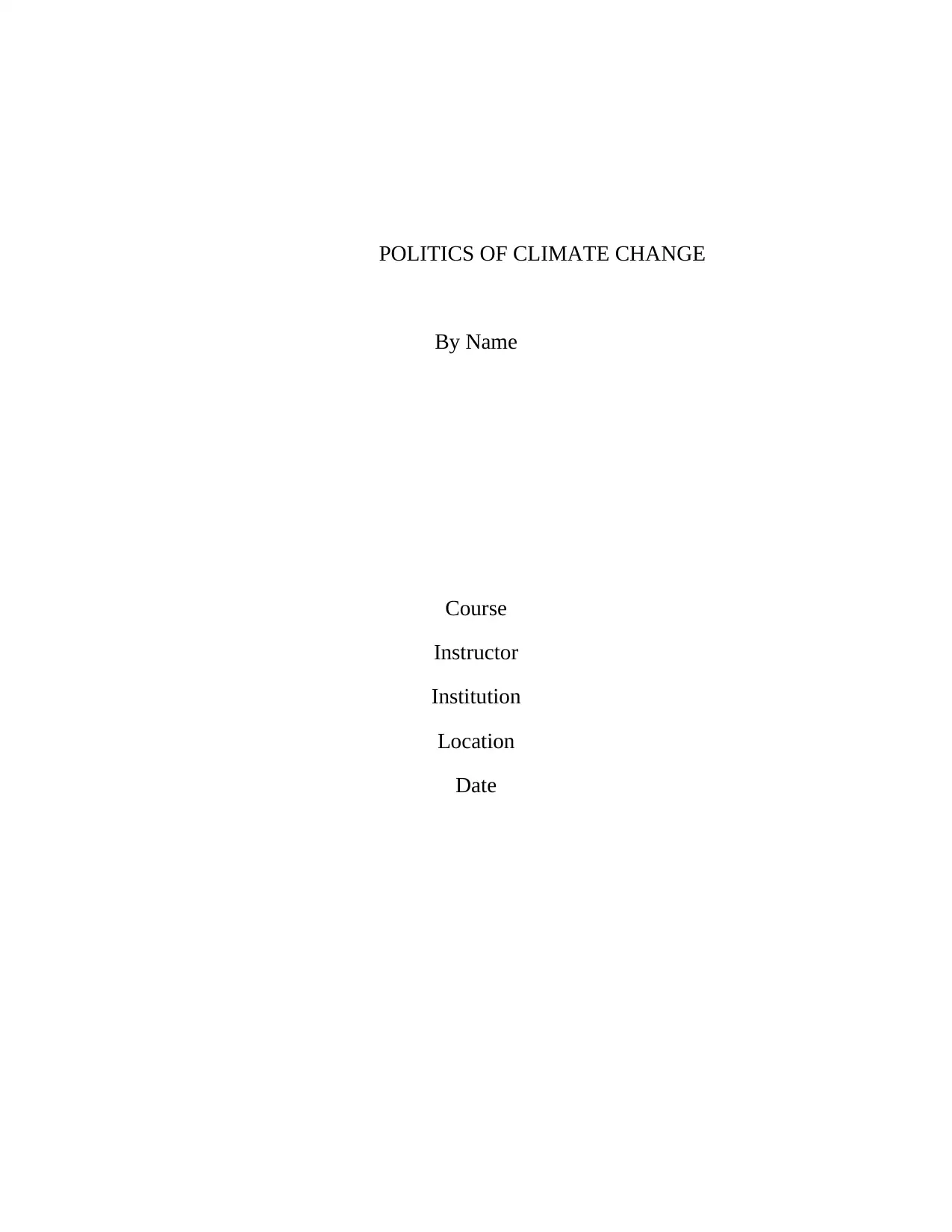
POLITICS OF CLIMATE CHANGE
By Name
Course
Instructor
Institution
Location
Date
By Name
Course
Instructor
Institution
Location
Date
Paraphrase This Document
Need a fresh take? Get an instant paraphrase of this document with our AI Paraphraser
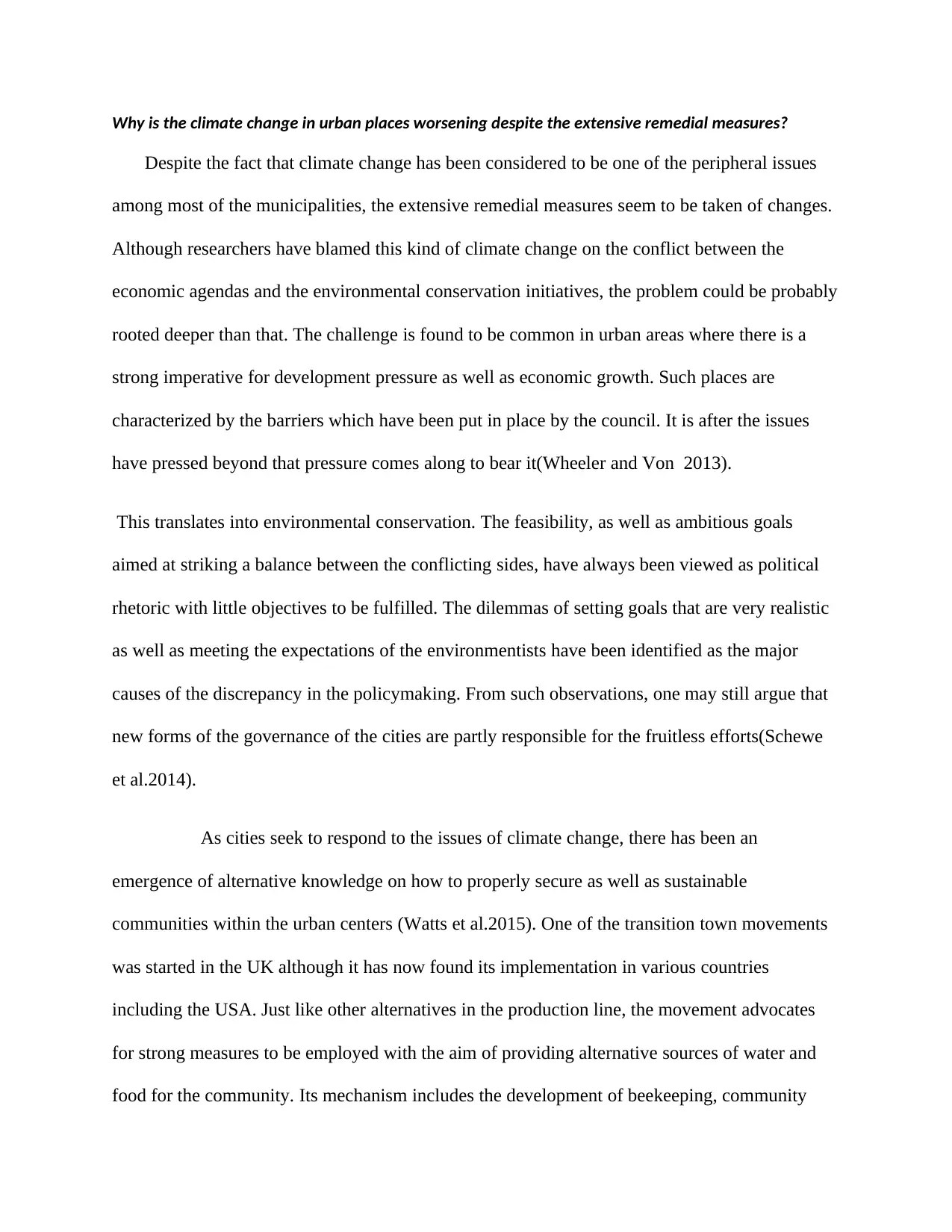
Why is the climate change in urban places worsening despite the extensive remedial measures?
Despite the fact that climate change has been considered to be one of the peripheral issues
among most of the municipalities, the extensive remedial measures seem to be taken of changes.
Although researchers have blamed this kind of climate change on the conflict between the
economic agendas and the environmental conservation initiatives, the problem could be probably
rooted deeper than that. The challenge is found to be common in urban areas where there is a
strong imperative for development pressure as well as economic growth. Such places are
characterized by the barriers which have been put in place by the council. It is after the issues
have pressed beyond that pressure comes along to bear it(Wheeler and Von 2013).
This translates into environmental conservation. The feasibility, as well as ambitious goals
aimed at striking a balance between the conflicting sides, have always been viewed as political
rhetoric with little objectives to be fulfilled. The dilemmas of setting goals that are very realistic
as well as meeting the expectations of the environmentists have been identified as the major
causes of the discrepancy in the policymaking. From such observations, one may still argue that
new forms of the governance of the cities are partly responsible for the fruitless efforts(Schewe
et al.2014).
As cities seek to respond to the issues of climate change, there has been an
emergence of alternative knowledge on how to properly secure as well as sustainable
communities within the urban centers (Watts et al.2015). One of the transition town movements
was started in the UK although it has now found its implementation in various countries
including the USA. Just like other alternatives in the production line, the movement advocates
for strong measures to be employed with the aim of providing alternative sources of water and
food for the community. Its mechanism includes the development of beekeeping, community
Despite the fact that climate change has been considered to be one of the peripheral issues
among most of the municipalities, the extensive remedial measures seem to be taken of changes.
Although researchers have blamed this kind of climate change on the conflict between the
economic agendas and the environmental conservation initiatives, the problem could be probably
rooted deeper than that. The challenge is found to be common in urban areas where there is a
strong imperative for development pressure as well as economic growth. Such places are
characterized by the barriers which have been put in place by the council. It is after the issues
have pressed beyond that pressure comes along to bear it(Wheeler and Von 2013).
This translates into environmental conservation. The feasibility, as well as ambitious goals
aimed at striking a balance between the conflicting sides, have always been viewed as political
rhetoric with little objectives to be fulfilled. The dilemmas of setting goals that are very realistic
as well as meeting the expectations of the environmentists have been identified as the major
causes of the discrepancy in the policymaking. From such observations, one may still argue that
new forms of the governance of the cities are partly responsible for the fruitless efforts(Schewe
et al.2014).
As cities seek to respond to the issues of climate change, there has been an
emergence of alternative knowledge on how to properly secure as well as sustainable
communities within the urban centers (Watts et al.2015). One of the transition town movements
was started in the UK although it has now found its implementation in various countries
including the USA. Just like other alternatives in the production line, the movement advocates
for strong measures to be employed with the aim of providing alternative sources of water and
food for the community. Its mechanism includes the development of beekeeping, community
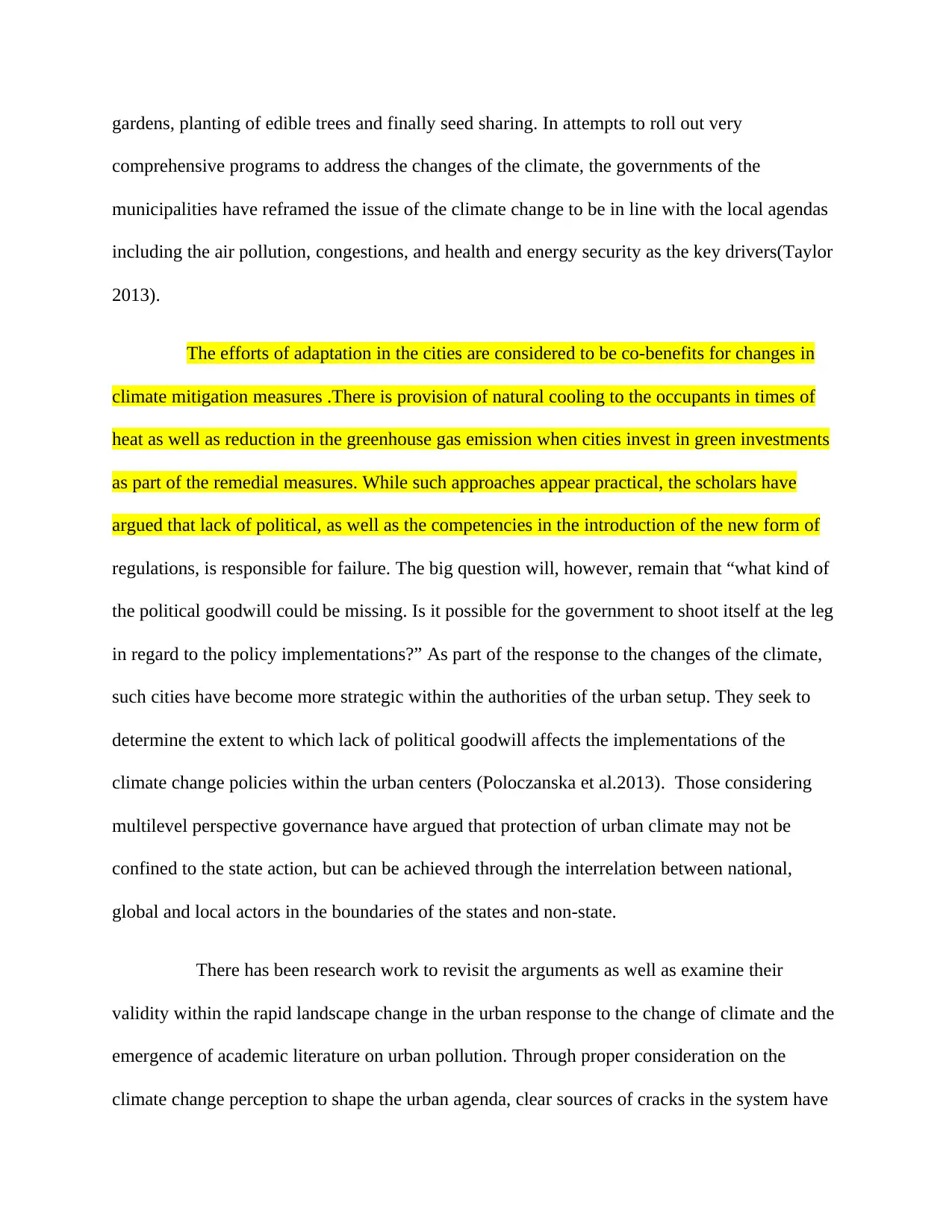
gardens, planting of edible trees and finally seed sharing. In attempts to roll out very
comprehensive programs to address the changes of the climate, the governments of the
municipalities have reframed the issue of the climate change to be in line with the local agendas
including the air pollution, congestions, and health and energy security as the key drivers(Taylor
2013).
The efforts of adaptation in the cities are considered to be co-benefits for changes in
climate mitigation measures .There is provision of natural cooling to the occupants in times of
heat as well as reduction in the greenhouse gas emission when cities invest in green investments
as part of the remedial measures. While such approaches appear practical, the scholars have
argued that lack of political, as well as the competencies in the introduction of the new form of
regulations, is responsible for failure. The big question will, however, remain that “what kind of
the political goodwill could be missing. Is it possible for the government to shoot itself at the leg
in regard to the policy implementations?” As part of the response to the changes of the climate,
such cities have become more strategic within the authorities of the urban setup. They seek to
determine the extent to which lack of political goodwill affects the implementations of the
climate change policies within the urban centers (Poloczanska et al.2013). Those considering
multilevel perspective governance have argued that protection of urban climate may not be
confined to the state action, but can be achieved through the interrelation between national,
global and local actors in the boundaries of the states and non-state.
There has been research work to revisit the arguments as well as examine their
validity within the rapid landscape change in the urban response to the change of climate and the
emergence of academic literature on urban pollution. Through proper consideration on the
climate change perception to shape the urban agenda, clear sources of cracks in the system have
comprehensive programs to address the changes of the climate, the governments of the
municipalities have reframed the issue of the climate change to be in line with the local agendas
including the air pollution, congestions, and health and energy security as the key drivers(Taylor
2013).
The efforts of adaptation in the cities are considered to be co-benefits for changes in
climate mitigation measures .There is provision of natural cooling to the occupants in times of
heat as well as reduction in the greenhouse gas emission when cities invest in green investments
as part of the remedial measures. While such approaches appear practical, the scholars have
argued that lack of political, as well as the competencies in the introduction of the new form of
regulations, is responsible for failure. The big question will, however, remain that “what kind of
the political goodwill could be missing. Is it possible for the government to shoot itself at the leg
in regard to the policy implementations?” As part of the response to the changes of the climate,
such cities have become more strategic within the authorities of the urban setup. They seek to
determine the extent to which lack of political goodwill affects the implementations of the
climate change policies within the urban centers (Poloczanska et al.2013). Those considering
multilevel perspective governance have argued that protection of urban climate may not be
confined to the state action, but can be achieved through the interrelation between national,
global and local actors in the boundaries of the states and non-state.
There has been research work to revisit the arguments as well as examine their
validity within the rapid landscape change in the urban response to the change of climate and the
emergence of academic literature on urban pollution. Through proper consideration on the
climate change perception to shape the urban agenda, clear sources of cracks in the system have
You're viewing a preview
Unlock full access by subscribing today!
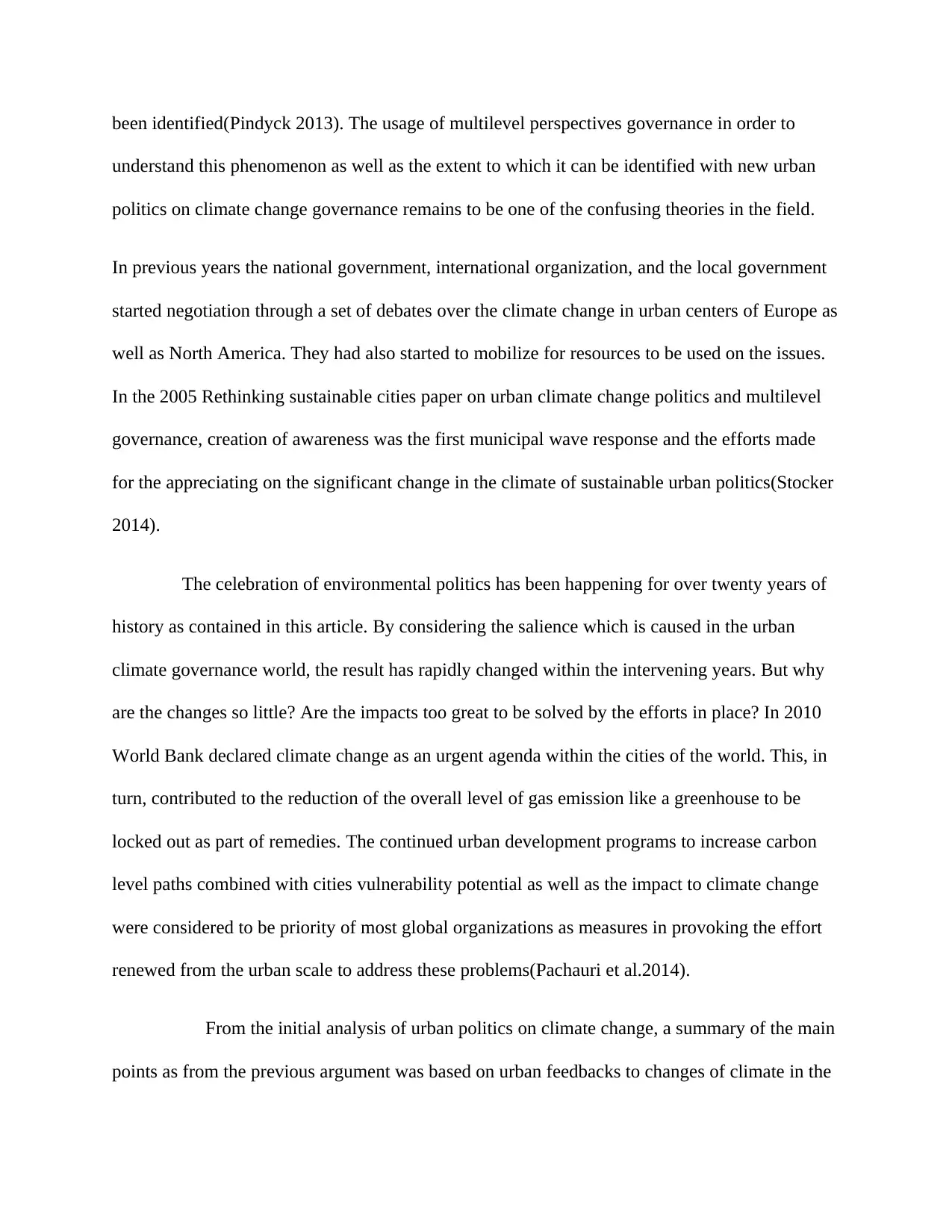
been identified(Pindyck 2013). The usage of multilevel perspectives governance in order to
understand this phenomenon as well as the extent to which it can be identified with new urban
politics on climate change governance remains to be one of the confusing theories in the field.
In previous years the national government, international organization, and the local government
started negotiation through a set of debates over the climate change in urban centers of Europe as
well as North America. They had also started to mobilize for resources to be used on the issues.
In the 2005 Rethinking sustainable cities paper on urban climate change politics and multilevel
governance, creation of awareness was the first municipal wave response and the efforts made
for the appreciating on the significant change in the climate of sustainable urban politics(Stocker
2014).
The celebration of environmental politics has been happening for over twenty years of
history as contained in this article. By considering the salience which is caused in the urban
climate governance world, the result has rapidly changed within the intervening years. But why
are the changes so little? Are the impacts too great to be solved by the efforts in place? In 2010
World Bank declared climate change as an urgent agenda within the cities of the world. This, in
turn, contributed to the reduction of the overall level of gas emission like a greenhouse to be
locked out as part of remedies. The continued urban development programs to increase carbon
level paths combined with cities vulnerability potential as well as the impact to climate change
were considered to be priority of most global organizations as measures in provoking the effort
renewed from the urban scale to address these problems(Pachauri et al.2014).
From the initial analysis of urban politics on climate change, a summary of the main
points as from the previous argument was based on urban feedbacks to changes of climate in the
understand this phenomenon as well as the extent to which it can be identified with new urban
politics on climate change governance remains to be one of the confusing theories in the field.
In previous years the national government, international organization, and the local government
started negotiation through a set of debates over the climate change in urban centers of Europe as
well as North America. They had also started to mobilize for resources to be used on the issues.
In the 2005 Rethinking sustainable cities paper on urban climate change politics and multilevel
governance, creation of awareness was the first municipal wave response and the efforts made
for the appreciating on the significant change in the climate of sustainable urban politics(Stocker
2014).
The celebration of environmental politics has been happening for over twenty years of
history as contained in this article. By considering the salience which is caused in the urban
climate governance world, the result has rapidly changed within the intervening years. But why
are the changes so little? Are the impacts too great to be solved by the efforts in place? In 2010
World Bank declared climate change as an urgent agenda within the cities of the world. This, in
turn, contributed to the reduction of the overall level of gas emission like a greenhouse to be
locked out as part of remedies. The continued urban development programs to increase carbon
level paths combined with cities vulnerability potential as well as the impact to climate change
were considered to be priority of most global organizations as measures in provoking the effort
renewed from the urban scale to address these problems(Pachauri et al.2014).
From the initial analysis of urban politics on climate change, a summary of the main
points as from the previous argument was based on urban feedbacks to changes of climate in the
Paraphrase This Document
Need a fresh take? Get an instant paraphrase of this document with our AI Paraphraser

countries as UK, Australia, and the US. Although it would have been better to do a comparison,
this particular study mostly focused on planning and climate change in the UK. Some of the
arguments retain their validity because there has been similarity in regard to the methods of the
research. The research methods which have been developed by cities in response to the
increasing urban climate change as well as how to acquire more strategies needed in approaching
the municipal climate challenge action in the original analysis have been based on the multilevel
governance perspective.
As part of the remedial measures most cities in countries like UK have been adopting
creation of awareness programs on climate change to incorporate the vulnerable groups like
children and women in the environmental conservation. This goes hand in hand with adaptive
measures of creating very resilient and reliable urban infrastructure. Whereas the sustainable
cities approaches provoke the interest on how cities can be implicated in pollution as well as
responding to the global issues of environment in a sequential manner, the analysis required is to
show how it happens. It is grounded in what some scholar referred to as a ‘new localism'
consisting of framework which is locally regarded as a social-spatial container in which
institutional summation, physical and social relation required in the achievement of more
sustainable future products.
The framing was considered as one of the barriers in understanding the channel via which a
large economic, social and political process is used in configuring urban
possibilities(Hirabayashi et al 2013). In general sustainability and the responses of climate
change, in particular, have been found to be interlinked through such analysis. If only it would
have been possible to consider the steps beyond the local set up and in accordance with the
reference frame proposed by a group of scholars, the efforts to address climate change would
this particular study mostly focused on planning and climate change in the UK. Some of the
arguments retain their validity because there has been similarity in regard to the methods of the
research. The research methods which have been developed by cities in response to the
increasing urban climate change as well as how to acquire more strategies needed in approaching
the municipal climate challenge action in the original analysis have been based on the multilevel
governance perspective.
As part of the remedial measures most cities in countries like UK have been adopting
creation of awareness programs on climate change to incorporate the vulnerable groups like
children and women in the environmental conservation. This goes hand in hand with adaptive
measures of creating very resilient and reliable urban infrastructure. Whereas the sustainable
cities approaches provoke the interest on how cities can be implicated in pollution as well as
responding to the global issues of environment in a sequential manner, the analysis required is to
show how it happens. It is grounded in what some scholar referred to as a ‘new localism'
consisting of framework which is locally regarded as a social-spatial container in which
institutional summation, physical and social relation required in the achievement of more
sustainable future products.
The framing was considered as one of the barriers in understanding the channel via which a
large economic, social and political process is used in configuring urban
possibilities(Hirabayashi et al 2013). In general sustainability and the responses of climate
change, in particular, have been found to be interlinked through such analysis. If only it would
have been possible to consider the steps beyond the local set up and in accordance with the
reference frame proposed by a group of scholars, the efforts to address climate change would
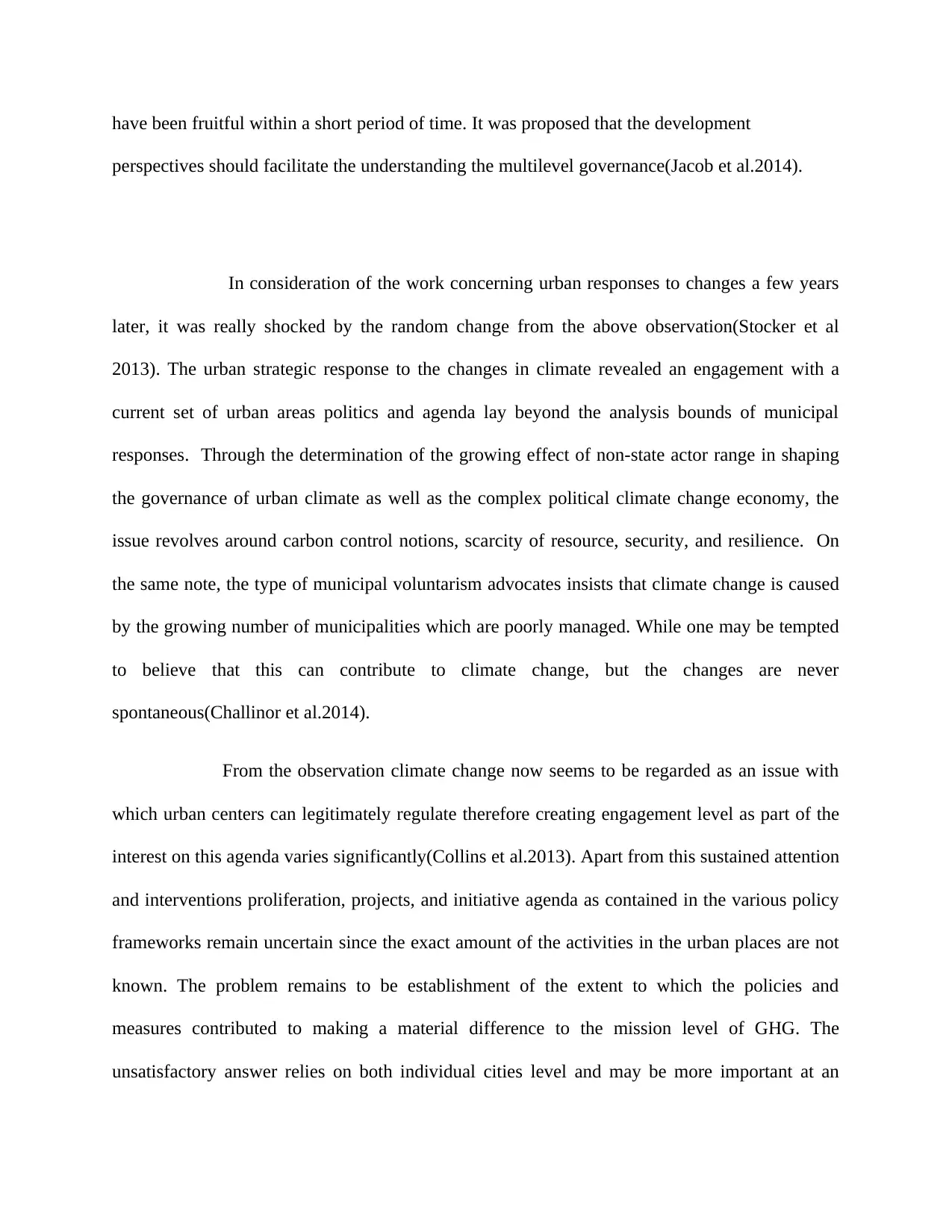
have been fruitful within a short period of time. It was proposed that the development
perspectives should facilitate the understanding the multilevel governance(Jacob et al.2014).
In consideration of the work concerning urban responses to changes a few years
later, it was really shocked by the random change from the above observation(Stocker et al
2013). The urban strategic response to the changes in climate revealed an engagement with a
current set of urban areas politics and agenda lay beyond the analysis bounds of municipal
responses. Through the determination of the growing effect of non-state actor range in shaping
the governance of urban climate as well as the complex political climate change economy, the
issue revolves around carbon control notions, scarcity of resource, security, and resilience. On
the same note, the type of municipal voluntarism advocates insists that climate change is caused
by the growing number of municipalities which are poorly managed. While one may be tempted
to believe that this can contribute to climate change, but the changes are never
spontaneous(Challinor et al.2014).
From the observation climate change now seems to be regarded as an issue with
which urban centers can legitimately regulate therefore creating engagement level as part of the
interest on this agenda varies significantly(Collins et al.2013). Apart from this sustained attention
and interventions proliferation, projects, and initiative agenda as contained in the various policy
frameworks remain uncertain since the exact amount of the activities in the urban places are not
known. The problem remains to be establishment of the extent to which the policies and
measures contributed to making a material difference to the mission level of GHG. The
unsatisfactory answer relies on both individual cities level and may be more important at an
perspectives should facilitate the understanding the multilevel governance(Jacob et al.2014).
In consideration of the work concerning urban responses to changes a few years
later, it was really shocked by the random change from the above observation(Stocker et al
2013). The urban strategic response to the changes in climate revealed an engagement with a
current set of urban areas politics and agenda lay beyond the analysis bounds of municipal
responses. Through the determination of the growing effect of non-state actor range in shaping
the governance of urban climate as well as the complex political climate change economy, the
issue revolves around carbon control notions, scarcity of resource, security, and resilience. On
the same note, the type of municipal voluntarism advocates insists that climate change is caused
by the growing number of municipalities which are poorly managed. While one may be tempted
to believe that this can contribute to climate change, but the changes are never
spontaneous(Challinor et al.2014).
From the observation climate change now seems to be regarded as an issue with
which urban centers can legitimately regulate therefore creating engagement level as part of the
interest on this agenda varies significantly(Collins et al.2013). Apart from this sustained attention
and interventions proliferation, projects, and initiative agenda as contained in the various policy
frameworks remain uncertain since the exact amount of the activities in the urban places are not
known. The problem remains to be establishment of the extent to which the policies and
measures contributed to making a material difference to the mission level of GHG. The
unsatisfactory answer relies on both individual cities level and may be more important at an
You're viewing a preview
Unlock full access by subscribing today!
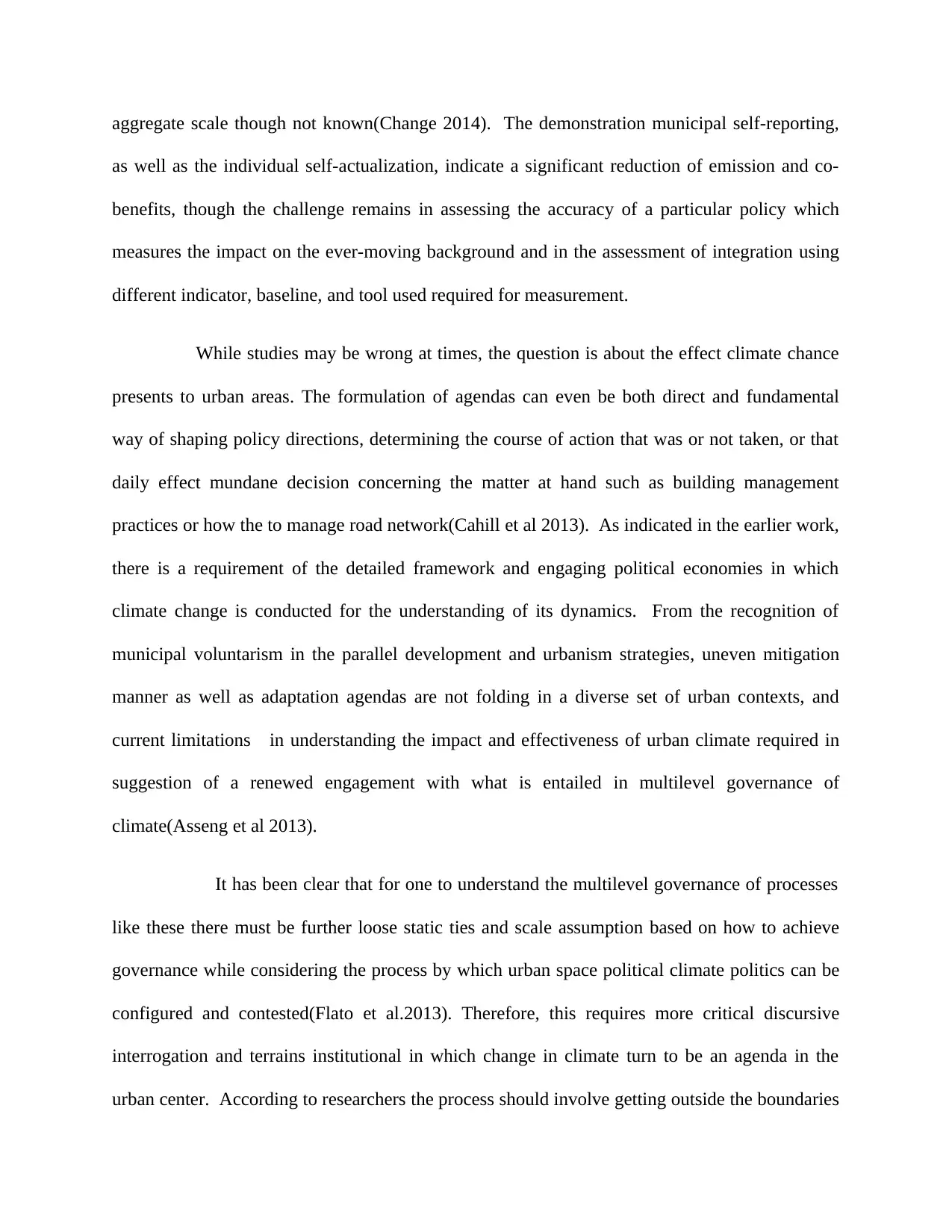
aggregate scale though not known(Change 2014). The demonstration municipal self-reporting,
as well as the individual self-actualization, indicate a significant reduction of emission and co-
benefits, though the challenge remains in assessing the accuracy of a particular policy which
measures the impact on the ever-moving background and in the assessment of integration using
different indicator, baseline, and tool used required for measurement.
While studies may be wrong at times, the question is about the effect climate chance
presents to urban areas. The formulation of agendas can even be both direct and fundamental
way of shaping policy directions, determining the course of action that was or not taken, or that
daily effect mundane decision concerning the matter at hand such as building management
practices or how the to manage road network(Cahill et al 2013). As indicated in the earlier work,
there is a requirement of the detailed framework and engaging political economies in which
climate change is conducted for the understanding of its dynamics. From the recognition of
municipal voluntarism in the parallel development and urbanism strategies, uneven mitigation
manner as well as adaptation agendas are not folding in a diverse set of urban contexts, and
current limitations in understanding the impact and effectiveness of urban climate required in
suggestion of a renewed engagement with what is entailed in multilevel governance of
climate(Asseng et al 2013).
It has been clear that for one to understand the multilevel governance of processes
like these there must be further loose static ties and scale assumption based on how to achieve
governance while considering the process by which urban space political climate politics can be
configured and contested(Flato et al.2013). Therefore, this requires more critical discursive
interrogation and terrains institutional in which change in climate turn to be an agenda in the
urban center. According to researchers the process should involve getting outside the boundaries
as well as the individual self-actualization, indicate a significant reduction of emission and co-
benefits, though the challenge remains in assessing the accuracy of a particular policy which
measures the impact on the ever-moving background and in the assessment of integration using
different indicator, baseline, and tool used required for measurement.
While studies may be wrong at times, the question is about the effect climate chance
presents to urban areas. The formulation of agendas can even be both direct and fundamental
way of shaping policy directions, determining the course of action that was or not taken, or that
daily effect mundane decision concerning the matter at hand such as building management
practices or how the to manage road network(Cahill et al 2013). As indicated in the earlier work,
there is a requirement of the detailed framework and engaging political economies in which
climate change is conducted for the understanding of its dynamics. From the recognition of
municipal voluntarism in the parallel development and urbanism strategies, uneven mitigation
manner as well as adaptation agendas are not folding in a diverse set of urban contexts, and
current limitations in understanding the impact and effectiveness of urban climate required in
suggestion of a renewed engagement with what is entailed in multilevel governance of
climate(Asseng et al 2013).
It has been clear that for one to understand the multilevel governance of processes
like these there must be further loose static ties and scale assumption based on how to achieve
governance while considering the process by which urban space political climate politics can be
configured and contested(Flato et al.2013). Therefore, this requires more critical discursive
interrogation and terrains institutional in which change in climate turn to be an agenda in the
urban center. According to researchers the process should involve getting outside the boundaries
Paraphrase This Document
Need a fresh take? Get an instant paraphrase of this document with our AI Paraphraser
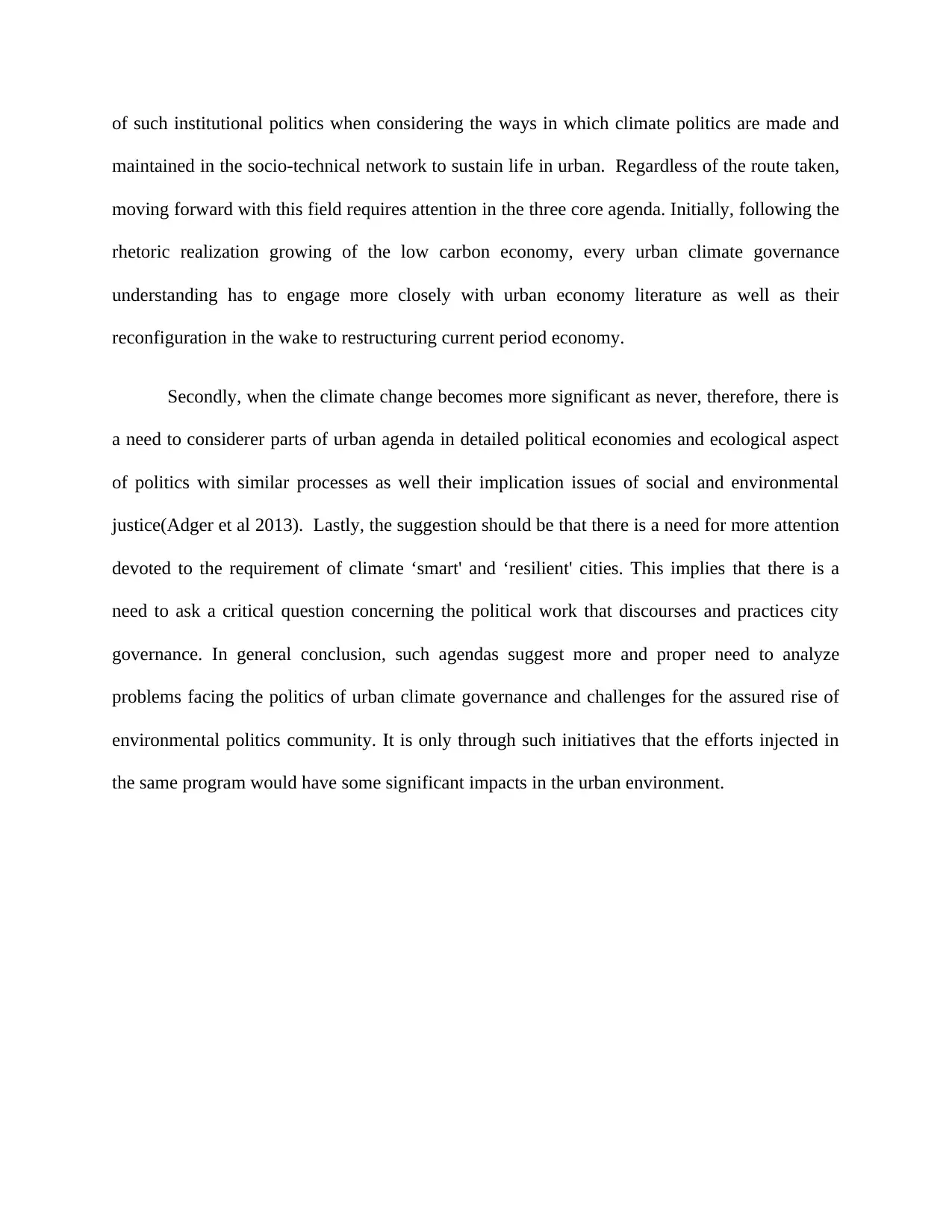
of such institutional politics when considering the ways in which climate politics are made and
maintained in the socio-technical network to sustain life in urban. Regardless of the route taken,
moving forward with this field requires attention in the three core agenda. Initially, following the
rhetoric realization growing of the low carbon economy, every urban climate governance
understanding has to engage more closely with urban economy literature as well as their
reconfiguration in the wake to restructuring current period economy.
Secondly, when the climate change becomes more significant as never, therefore, there is
a need to considerer parts of urban agenda in detailed political economies and ecological aspect
of politics with similar processes as well their implication issues of social and environmental
justice(Adger et al 2013). Lastly, the suggestion should be that there is a need for more attention
devoted to the requirement of climate ‘smart' and ‘resilient' cities. This implies that there is a
need to ask a critical question concerning the political work that discourses and practices city
governance. In general conclusion, such agendas suggest more and proper need to analyze
problems facing the politics of urban climate governance and challenges for the assured rise of
environmental politics community. It is only through such initiatives that the efforts injected in
the same program would have some significant impacts in the urban environment.
maintained in the socio-technical network to sustain life in urban. Regardless of the route taken,
moving forward with this field requires attention in the three core agenda. Initially, following the
rhetoric realization growing of the low carbon economy, every urban climate governance
understanding has to engage more closely with urban economy literature as well as their
reconfiguration in the wake to restructuring current period economy.
Secondly, when the climate change becomes more significant as never, therefore, there is
a need to considerer parts of urban agenda in detailed political economies and ecological aspect
of politics with similar processes as well their implication issues of social and environmental
justice(Adger et al 2013). Lastly, the suggestion should be that there is a need for more attention
devoted to the requirement of climate ‘smart' and ‘resilient' cities. This implies that there is a
need to ask a critical question concerning the political work that discourses and practices city
governance. In general conclusion, such agendas suggest more and proper need to analyze
problems facing the politics of urban climate governance and challenges for the assured rise of
environmental politics community. It is only through such initiatives that the efforts injected in
the same program would have some significant impacts in the urban environment.
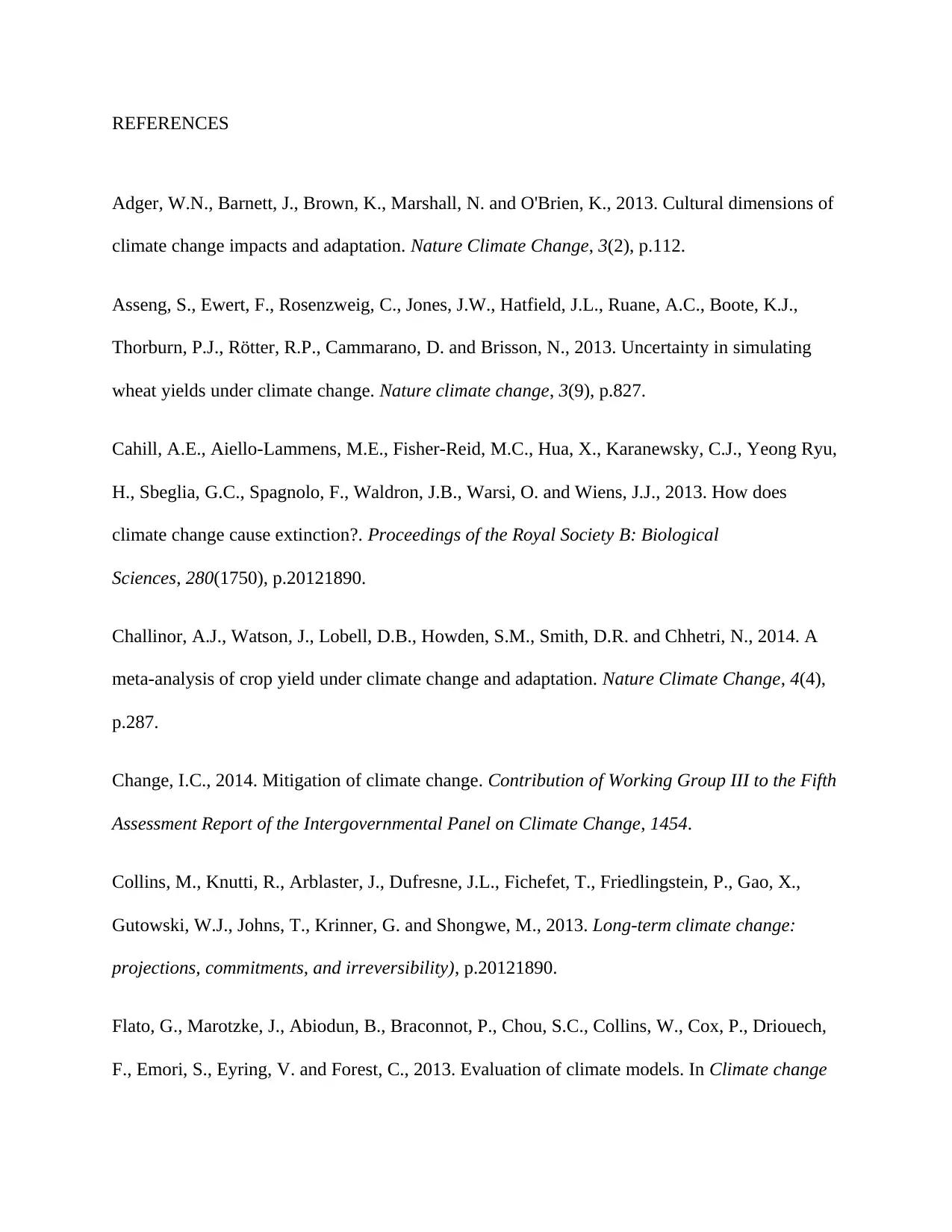
REFERENCES
Adger, W.N., Barnett, J., Brown, K., Marshall, N. and O'Brien, K., 2013. Cultural dimensions of
climate change impacts and adaptation. Nature Climate Change, 3(2), p.112.
Asseng, S., Ewert, F., Rosenzweig, C., Jones, J.W., Hatfield, J.L., Ruane, A.C., Boote, K.J.,
Thorburn, P.J., Rötter, R.P., Cammarano, D. and Brisson, N., 2013. Uncertainty in simulating
wheat yields under climate change. Nature climate change, 3(9), p.827.
Cahill, A.E., Aiello-Lammens, M.E., Fisher-Reid, M.C., Hua, X., Karanewsky, C.J., Yeong Ryu,
H., Sbeglia, G.C., Spagnolo, F., Waldron, J.B., Warsi, O. and Wiens, J.J., 2013. How does
climate change cause extinction?. Proceedings of the Royal Society B: Biological
Sciences, 280(1750), p.20121890.
Challinor, A.J., Watson, J., Lobell, D.B., Howden, S.M., Smith, D.R. and Chhetri, N., 2014. A
meta-analysis of crop yield under climate change and adaptation. Nature Climate Change, 4(4),
p.287.
Change, I.C., 2014. Mitigation of climate change. Contribution of Working Group III to the Fifth
Assessment Report of the Intergovernmental Panel on Climate Change, 1454.
Collins, M., Knutti, R., Arblaster, J., Dufresne, J.L., Fichefet, T., Friedlingstein, P., Gao, X.,
Gutowski, W.J., Johns, T., Krinner, G. and Shongwe, M., 2013. Long-term climate change:
projections, commitments, and irreversibility), p.20121890.
Flato, G., Marotzke, J., Abiodun, B., Braconnot, P., Chou, S.C., Collins, W., Cox, P., Driouech,
F., Emori, S., Eyring, V. and Forest, C., 2013. Evaluation of climate models. In Climate change
Adger, W.N., Barnett, J., Brown, K., Marshall, N. and O'Brien, K., 2013. Cultural dimensions of
climate change impacts and adaptation. Nature Climate Change, 3(2), p.112.
Asseng, S., Ewert, F., Rosenzweig, C., Jones, J.W., Hatfield, J.L., Ruane, A.C., Boote, K.J.,
Thorburn, P.J., Rötter, R.P., Cammarano, D. and Brisson, N., 2013. Uncertainty in simulating
wheat yields under climate change. Nature climate change, 3(9), p.827.
Cahill, A.E., Aiello-Lammens, M.E., Fisher-Reid, M.C., Hua, X., Karanewsky, C.J., Yeong Ryu,
H., Sbeglia, G.C., Spagnolo, F., Waldron, J.B., Warsi, O. and Wiens, J.J., 2013. How does
climate change cause extinction?. Proceedings of the Royal Society B: Biological
Sciences, 280(1750), p.20121890.
Challinor, A.J., Watson, J., Lobell, D.B., Howden, S.M., Smith, D.R. and Chhetri, N., 2014. A
meta-analysis of crop yield under climate change and adaptation. Nature Climate Change, 4(4),
p.287.
Change, I.C., 2014. Mitigation of climate change. Contribution of Working Group III to the Fifth
Assessment Report of the Intergovernmental Panel on Climate Change, 1454.
Collins, M., Knutti, R., Arblaster, J., Dufresne, J.L., Fichefet, T., Friedlingstein, P., Gao, X.,
Gutowski, W.J., Johns, T., Krinner, G. and Shongwe, M., 2013. Long-term climate change:
projections, commitments, and irreversibility), p.20121890.
Flato, G., Marotzke, J., Abiodun, B., Braconnot, P., Chou, S.C., Collins, W., Cox, P., Driouech,
F., Emori, S., Eyring, V. and Forest, C., 2013. Evaluation of climate models. In Climate change
You're viewing a preview
Unlock full access by subscribing today!
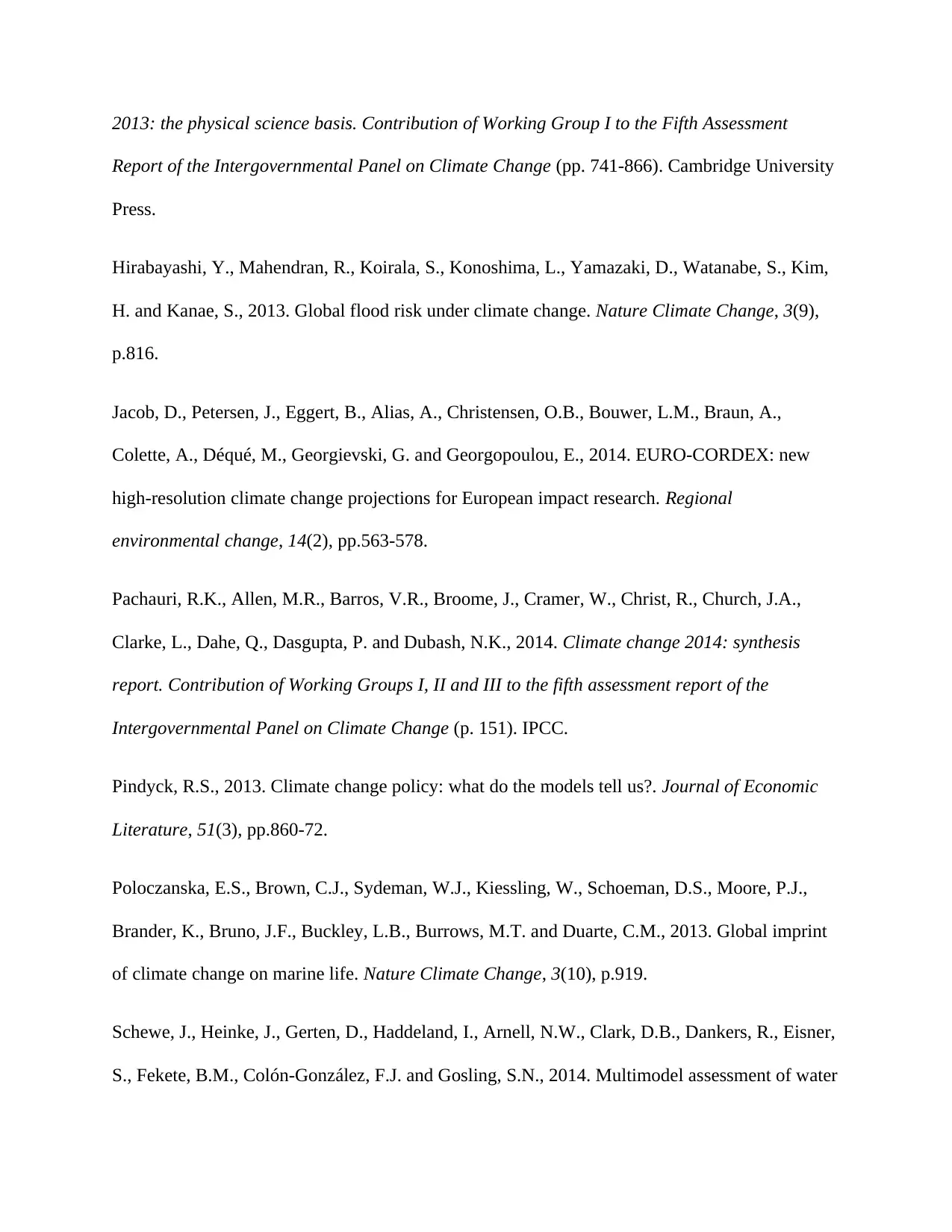
2013: the physical science basis. Contribution of Working Group I to the Fifth Assessment
Report of the Intergovernmental Panel on Climate Change (pp. 741-866). Cambridge University
Press.
Hirabayashi, Y., Mahendran, R., Koirala, S., Konoshima, L., Yamazaki, D., Watanabe, S., Kim,
H. and Kanae, S., 2013. Global flood risk under climate change. Nature Climate Change, 3(9),
p.816.
Jacob, D., Petersen, J., Eggert, B., Alias, A., Christensen, O.B., Bouwer, L.M., Braun, A.,
Colette, A., Déqué, M., Georgievski, G. and Georgopoulou, E., 2014. EURO-CORDEX: new
high-resolution climate change projections for European impact research. Regional
environmental change, 14(2), pp.563-578.
Pachauri, R.K., Allen, M.R., Barros, V.R., Broome, J., Cramer, W., Christ, R., Church, J.A.,
Clarke, L., Dahe, Q., Dasgupta, P. and Dubash, N.K., 2014. Climate change 2014: synthesis
report. Contribution of Working Groups I, II and III to the fifth assessment report of the
Intergovernmental Panel on Climate Change (p. 151). IPCC.
Pindyck, R.S., 2013. Climate change policy: what do the models tell us?. Journal of Economic
Literature, 51(3), pp.860-72.
Poloczanska, E.S., Brown, C.J., Sydeman, W.J., Kiessling, W., Schoeman, D.S., Moore, P.J.,
Brander, K., Bruno, J.F., Buckley, L.B., Burrows, M.T. and Duarte, C.M., 2013. Global imprint
of climate change on marine life. Nature Climate Change, 3(10), p.919.
Schewe, J., Heinke, J., Gerten, D., Haddeland, I., Arnell, N.W., Clark, D.B., Dankers, R., Eisner,
S., Fekete, B.M., Colón-González, F.J. and Gosling, S.N., 2014. Multimodel assessment of water
Report of the Intergovernmental Panel on Climate Change (pp. 741-866). Cambridge University
Press.
Hirabayashi, Y., Mahendran, R., Koirala, S., Konoshima, L., Yamazaki, D., Watanabe, S., Kim,
H. and Kanae, S., 2013. Global flood risk under climate change. Nature Climate Change, 3(9),
p.816.
Jacob, D., Petersen, J., Eggert, B., Alias, A., Christensen, O.B., Bouwer, L.M., Braun, A.,
Colette, A., Déqué, M., Georgievski, G. and Georgopoulou, E., 2014. EURO-CORDEX: new
high-resolution climate change projections for European impact research. Regional
environmental change, 14(2), pp.563-578.
Pachauri, R.K., Allen, M.R., Barros, V.R., Broome, J., Cramer, W., Christ, R., Church, J.A.,
Clarke, L., Dahe, Q., Dasgupta, P. and Dubash, N.K., 2014. Climate change 2014: synthesis
report. Contribution of Working Groups I, II and III to the fifth assessment report of the
Intergovernmental Panel on Climate Change (p. 151). IPCC.
Pindyck, R.S., 2013. Climate change policy: what do the models tell us?. Journal of Economic
Literature, 51(3), pp.860-72.
Poloczanska, E.S., Brown, C.J., Sydeman, W.J., Kiessling, W., Schoeman, D.S., Moore, P.J.,
Brander, K., Bruno, J.F., Buckley, L.B., Burrows, M.T. and Duarte, C.M., 2013. Global imprint
of climate change on marine life. Nature Climate Change, 3(10), p.919.
Schewe, J., Heinke, J., Gerten, D., Haddeland, I., Arnell, N.W., Clark, D.B., Dankers, R., Eisner,
S., Fekete, B.M., Colón-González, F.J. and Gosling, S.N., 2014. Multimodel assessment of water
Paraphrase This Document
Need a fresh take? Get an instant paraphrase of this document with our AI Paraphraser
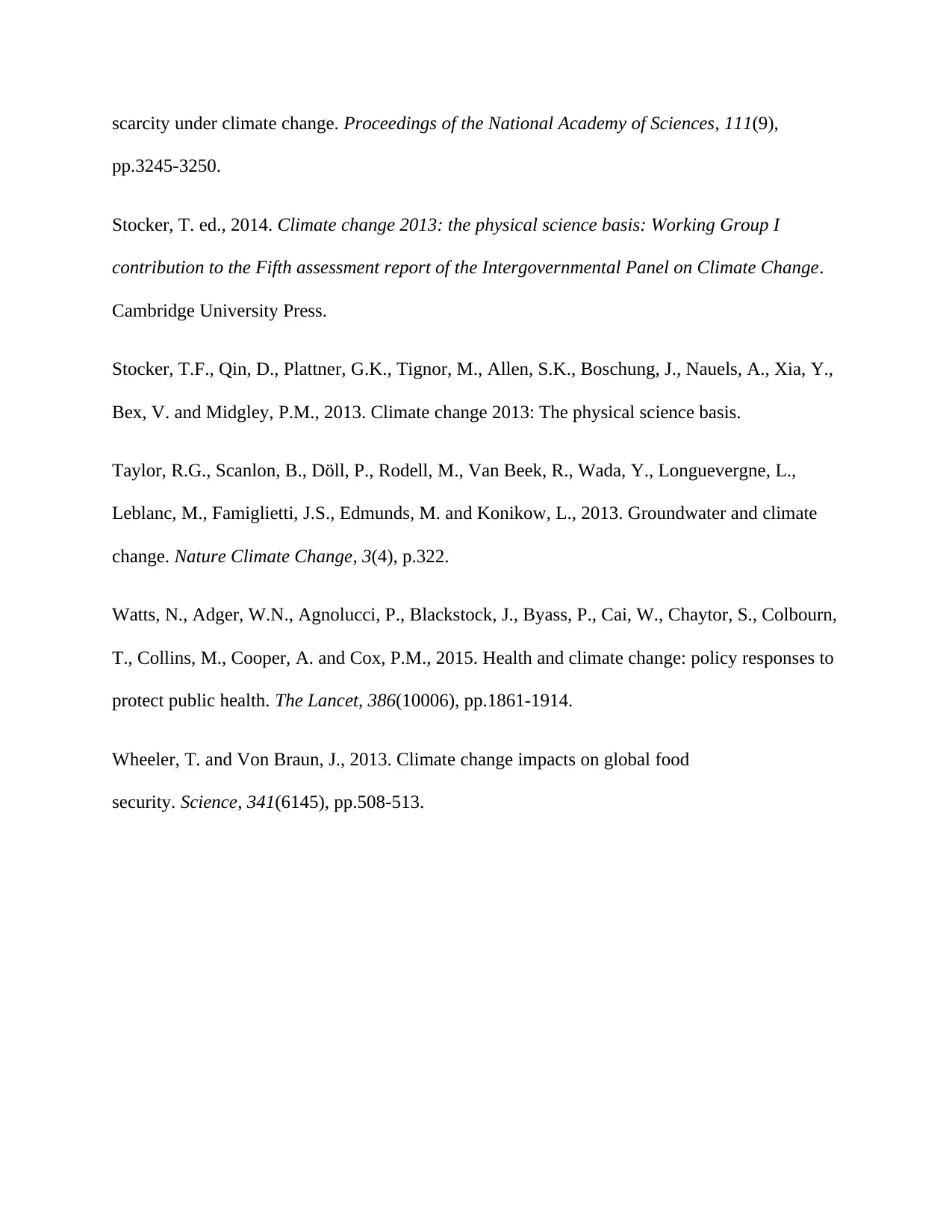
scarcity under climate change. Proceedings of the National Academy of Sciences, 111(9),
pp.3245-3250.
Stocker, T. ed., 2014. Climate change 2013: the physical science basis: Working Group I
contribution to the Fifth assessment report of the Intergovernmental Panel on Climate Change.
Cambridge University Press.
Stocker, T.F., Qin, D., Plattner, G.K., Tignor, M., Allen, S.K., Boschung, J., Nauels, A., Xia, Y.,
Bex, V. and Midgley, P.M., 2013. Climate change 2013: The physical science basis.
Taylor, R.G., Scanlon, B., Döll, P., Rodell, M., Van Beek, R., Wada, Y., Longuevergne, L.,
Leblanc, M., Famiglietti, J.S., Edmunds, M. and Konikow, L., 2013. Groundwater and climate
change. Nature Climate Change, 3(4), p.322.
Watts, N., Adger, W.N., Agnolucci, P., Blackstock, J., Byass, P., Cai, W., Chaytor, S., Colbourn,
T., Collins, M., Cooper, A. and Cox, P.M., 2015. Health and climate change: policy responses to
protect public health. The Lancet, 386(10006), pp.1861-1914.
Wheeler, T. and Von Braun, J., 2013. Climate change impacts on global food
security. Science, 341(6145), pp.508-513.
pp.3245-3250.
Stocker, T. ed., 2014. Climate change 2013: the physical science basis: Working Group I
contribution to the Fifth assessment report of the Intergovernmental Panel on Climate Change.
Cambridge University Press.
Stocker, T.F., Qin, D., Plattner, G.K., Tignor, M., Allen, S.K., Boschung, J., Nauels, A., Xia, Y.,
Bex, V. and Midgley, P.M., 2013. Climate change 2013: The physical science basis.
Taylor, R.G., Scanlon, B., Döll, P., Rodell, M., Van Beek, R., Wada, Y., Longuevergne, L.,
Leblanc, M., Famiglietti, J.S., Edmunds, M. and Konikow, L., 2013. Groundwater and climate
change. Nature Climate Change, 3(4), p.322.
Watts, N., Adger, W.N., Agnolucci, P., Blackstock, J., Byass, P., Cai, W., Chaytor, S., Colbourn,
T., Collins, M., Cooper, A. and Cox, P.M., 2015. Health and climate change: policy responses to
protect public health. The Lancet, 386(10006), pp.1861-1914.
Wheeler, T. and Von Braun, J., 2013. Climate change impacts on global food
security. Science, 341(6145), pp.508-513.
1 out of 11
Related Documents
Your All-in-One AI-Powered Toolkit for Academic Success.
+13062052269
info@desklib.com
Available 24*7 on WhatsApp / Email
![[object Object]](/_next/static/media/star-bottom.7253800d.svg)
Unlock your academic potential
© 2024 | Zucol Services PVT LTD | All rights reserved.





